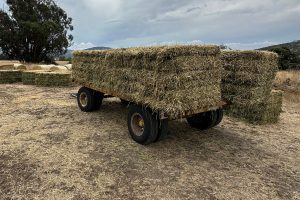Pasture & hay management: Keeping paddocks productive for the long haul
May 13, 2025 Australia
Managing pastures for hay and silage production is a balancing act. While harvesting pasture for conserved feed is essential for many farming systems, it also places stress on plants. Without careful management, pasture persistence can decline, leading to reduced regrowth, weed invasion, and lower production in the seasons ahead.
At AlfaGen Seeds, we believe in practical, research-backed strategies that help farmers maintain productive pastures year after year. Whether you’re working with perennial ryegrass, annual forage crops, or lucerne, these management tips will help keep your paddocks in top shape.
Managing pastures for resilience
Perennial grass-based pastures—such as perennial ryegrass—rely on tiller density to maintain productivity. Most new tillers form during key growth periods, so managing grazing and harvest timing is critical for long-term pasture health.
The key to strong pasture regrowth is managing tiller density:
- Frequent grazing keeps pastures shorter, encouraging tiller production
- Closing pastures for hay or silage reduces tiller density, slowing pasture recovery
- Earlier silage cutting reduces shading, helping new tillers form faster
If pastures are left closed too long, plants divert energy into reproductive growth, leading to weaker regrowth and fewer tillers heading into the next season.
The impact of hay & silage harvest timing
Harvest timing plays a huge role in pasture recovery and future yields.
Silage
Harvesting earlier in the growth cycle has less impact on tiller density than waiting longer for hay. Cutting silage at the right time can mean:
- Better pasture recovery
- Higher-quality feed
- Lower total yield but improved digestibility
Hay
Extended pasture closure before hay cutting leads to:
- Shading at the base of the plants, reducing new tiller formation
- Energy being diverted to reproductive growth, weakening regrowth potential
- Lower pasture recovery, impacting future grazing rotations
Tip: Harvesting before dry or hot conditions helps pasture recover faster and maintain productivity.
Annual forage crops vs perennial pasture harvest
For annual forage crops like annual ryegrass, oats, barley, and clovers, the harvest approach is different. Since these crops don’t need to persist beyond the season, the focus should be on:
- Maximising quality and yield rather than plant recovery
- Harvesting at peak nutritional value for livestock
Lucerne management also differs. While well-documented, key points include:
- Waiting for new shoots to form at the crown before cutting to maintain strong stem density
- Avoiding heavy cuts to prevent extended shading of new growth
The role of soil fertility after harvesting
- Every hay or silage harvest removes key nutrients from the soil, so fertiliser and soil fertility management are essential for long-term pasture productivity.
- Lucerne hay and silage deplete potassium, phosphate, and sulphur
- Grass-based pastures remove nitrogen, requiring fertiliser application after harvest
- Failure to replace lost nutrients can lead to:
- Weed invasion
- Declining soil health
- Reduced pasture persistence
Investing in balanced fertiliser applications after harvesting is the best way to keep paddocks productive.
Keeping pastures strong for the future
Good pasture management is about thinking beyond this season. Whether it’s strategic grazing, smart harvest timing, or soil fertility management, small decisions can have big impacts on pasture longevity and farm productivity.
Find the best pasture seed for your farm—explore our forage seed range, or talk to our team about the best options for your conditions.
